 From 1990-1995 my wife and I ran Café Troy, a coffeehouse in downtown Los Angeles. Together with a crew of unlikely cohorts comprised of friends and family we kept this bohemian outpost at the edge of Little Tokyo alive for five years.
From 1990-1995 my wife and I ran Café Troy, a coffeehouse in downtown Los Angeles. Together with a crew of unlikely cohorts comprised of friends and family we kept this bohemian outpost at the edge of Little Tokyo alive for five years.
When we opened Troy homelessness was at an all time high, due in no small part to the twelve years of Reagan-Bush-economics. Somehow that trickle seemed to stop quite a bit short in the actual practice of trickle down economics.
Today there are still between 1.5 and 3 million homeless in the United States in any given year. In a country that has one of the highest per capita incomes in the world this seems an unjustifiably high statistic. Identifying a problem is one thing; doing something about it is another. In many ways, large and small, many of us do what we can. Some do more.
Instead of adopting an aggressive or intolerant policy, we decided to try to live symbiotically and interact productively with our homeless friends. Over the first few months, the opportunities for exchange unfolded and an endearing few became a part of the café.
 Flower Guy was a tall and slender man. I never learned his real name. He was cheerful and always made people smile. He collected nearly dead flowers from the trash bins at the central flower mart then manicured and revivified them for sale at discount prices. The flowers never lived very long, about as long as the money remained in his possession probably, but they looked great while they lasted.
Flower Guy was a tall and slender man. I never learned his real name. He was cheerful and always made people smile. He collected nearly dead flowers from the trash bins at the central flower mart then manicured and revivified them for sale at discount prices. The flowers never lived very long, about as long as the money remained in his possession probably, but they looked great while they lasted.
Flower Guy almost always dressed entirely in white and maintained extraordinary hygiene for one without an address other than “Flower Mart – General Vicinity”. He made his rounds at night when homeless people and old flowers look their best. They both begin to wilt at dawn.
One night he showed up with a large stainless steel brace attached to his shoulders with circular rings holding his head in a stationary position. It looked like shiny rings of Saturn around his head.
Between his bright white clothing, his tremendous smile and the rings of Saturn he was quite an apparition. I’m sure his business increased with the addition of the medical device. People tend to give more when the disadvantage is enhanced by real or perceived disability.
Sadly, Flower Guy’s injury was all too real. While walking through downtown, he had been struck by an automobile. Without insurance, he was discharged as soon as he was deemed ambulatory. Hours after his release, he was working his beat once more.
Tommy was another of our downtown denizens. He was known as Nitro to some but I know he preferred Tommy so that is what we called him. Tommy always called me Daddy. I was about thirty at that time and Tommy was easily twenty years my senior, so it always made me smile. Tommy lived from recycling. One doesn’t teach the poor to be “green,” they can teach a master class. Tommy came in at night and picked up the bottles and cans and in exchange took our trash out to the dumpster out back.
Every now and then, Tommy had to borrow a little money; it was never more than a few dollars and he always paid it back. I sometimes wondered what it was for, but thought it was demeaning to ask him. I could either lend it to him or not. That was my business. If he wanted to tell me what it was for, that was his business.
One night about eleven o’clock, he came in very excited saying, “Daddy, I need three dollars. Daddy, lend me three dollars, Daddy.” This time, his obvious excitement intrigued me and my curiosity got the better of me. I asked him why. He took me by the arm escorting me out back to his shopping cart where a woman stood waiting for him. Tommy pointed and whispered she would sleep with him for three dollars.
In one glance I saw her emaciated frame, her gaunt face, and her tattered clothes. She smiled at me and winked. Her grin revealed more gaps than teeth. None of that was important. She was lovely. If she was going to make Tommy happy for a few minutes or a few hours, that was all that mattered. Three dollars seemed a very small price to pay.
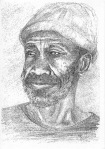 Frank Parker, the artist, was a Troy mainstay. He had a quick wit, a keen mind and was charming and graceful. He made wonderful jewelry from the leftovers of technology, mostly copper wire from buildings as they were being installed. Frank came and went as he pleased in the café and even slept there for a time as a stand-in “night watchman.”
Frank Parker, the artist, was a Troy mainstay. He had a quick wit, a keen mind and was charming and graceful. He made wonderful jewelry from the leftovers of technology, mostly copper wire from buildings as they were being installed. Frank came and went as he pleased in the café and even slept there for a time as a stand-in “night watchman.”
We became friends, as much as one homeless person can be friends with a non-homeless person. It was an easy but sometimes awkward relationship.
 Frank’s bracelets were called “frangs” and were quite popular with the Downtown LA art scene at that time. He would charge anywhere from two to five dollars depending on how much he needed the money and what the customer might be willing to pay. Some people paid more. Frank was cool about the entire process. I liked that about Frank.
Frank’s bracelets were called “frangs” and were quite popular with the Downtown LA art scene at that time. He would charge anywhere from two to five dollars depending on how much he needed the money and what the customer might be willing to pay. Some people paid more. Frank was cool about the entire process. I liked that about Frank.
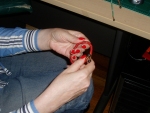 He was always working. When he sat around drinking coffee or smoking he would be making frangs. He started with a thick gauge copper wire and removed all the insulation so that it was only copper. Then he took very small copper wire with brightly colored insulation and wound it around the larger wire very tightly. Finally he bent back the ends of the thick copper wire and dipped the ends in a plastic like sealer made of the melted insulation removed earlier.
He was always working. When he sat around drinking coffee or smoking he would be making frangs. He started with a thick gauge copper wire and removed all the insulation so that it was only copper. Then he took very small copper wire with brightly colored insulation and wound it around the larger wire very tightly. Finally he bent back the ends of the thick copper wire and dipped the ends in a plastic like sealer made of the melted insulation removed earlier.
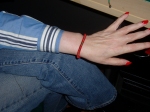 It was a brilliant use of what would normally be discarded, tossed out during the installation of a phone system in a building. Frank would find these piles of discarded wire everywhere, so he had endless free materials for his work. Once I became aware of these discards, I saw them everywhere too.
It was a brilliant use of what would normally be discarded, tossed out during the installation of a phone system in a building. Frank would find these piles of discarded wire everywhere, so he had endless free materials for his work. Once I became aware of these discards, I saw them everywhere too.
Frank was so easy-going about his craft that he could sell in the café whenever he wanted yet he would always ask permission, each and every time. He would approach people and if they were not receptive, he would move on. If they were interested then he showed them the current merchandise.
I often discussed his process with him because I was curious. I asked if certain colors sold better than others and how long it took to make them and if some wire was better than others.
One day I was standing behind the counter and Frank was at the back of the café working on his frangs. I looked up as a very tall man entered like he owned the world with large steps and an infectious good-natured grin. His big voice boomed out: “Frank Parker!”
The men embraced. The tall man was followed by someone I recognized, a very talented young lady, an artist and friend of my nephew. That’s my dad, she said, pointing at the big fellow. Indeed, it was the film director Ron Shelton. Frank and Ron had known each other years before.
After the café closed for good in 1995 I would sometimes see Frank downtown outside of Al’s Bar or in the area. I would always buy a frang or two. Sometimes he didn’t look well. I felt guilt. Illogical perhaps, but I did. If only I had been able to keep the café open then he might have more customers, like the old days when the place was packed night after night.
Several years later I received a phone call from a mutual friend, the acclaimed poet Dr. Mongo Taribubu. Most people call him Dr. Mongo. He left a message that Frank Parker was terminally ill and living in a hospice in East LA. He urged me to visit. It was a busy time for me and I didn’t return Dr. Mongo’s call right away.
The next call I received was to inform me of the services. The hospice house was packed for Frank’s service. It is surprising that one person without an address could know so many people. That was Frank. Bartenders, doormen, artists, community organizers, filmmakers, poets, musicians, everyone seemed to know Frank. Stacey, the bartender from Al’s Bar, tried to speak a few words about her friend but broke down and was unable to continue. It was then I decided not to speak. There was nothing to say. I participated as one of the many lives this wonderful man had touched in a very special way.
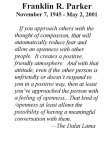 Near the end one fellow stood to speak. He had also been homeless and had known Frank from the streets. He spoke eloquently of what a good friend Frank had been. He spoke of his kindness and generosity. As he continued extolling Frank’s virtues he began to get emotional. Finally, he too had to stop. I will never forget the last thing he said. “We shared a box, man. We shared a box.”
Near the end one fellow stood to speak. He had also been homeless and had known Frank from the streets. He spoke eloquently of what a good friend Frank had been. He spoke of his kindness and generosity. As he continued extolling Frank’s virtues he began to get emotional. Finally, he too had to stop. I will never forget the last thing he said. “We shared a box, man. We shared a box.”
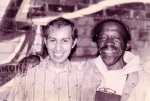 I had shared many things with Frank, a coffee, a cigarette, a hamburger, a conversation. None of it seemed as substantial to me as the memories that fellow carried of his friend Frank Parker.
I had shared many things with Frank, a coffee, a cigarette, a hamburger, a conversation. None of it seemed as substantial to me as the memories that fellow carried of his friend Frank Parker.
The next contestant in tonight’s episode of Meet the Homeless is a man known to one and all as Wyatt Earp. Wyatt was a maniac, plain and simple. He was about five and a half feet tall and never shut up. He had scruffy hair and a scruffy beard. His clothes were unkempt and he shuffled around like a midget Harlem Globetrotter, constantly moving. Hyper beyond bearing he would tease and harass you until you gave him money just to go away.
He operated a mobile car-washing service throughout the Little Tokyo area of Downtown LA. He usually carried a bucket with soap and water which he used to wash your car in our parking lot or on the street or wherever. He just wanted some money.
To this end he was also a sometime purveyor of all manner of dubiously acquired merchandise, each with an impeccable provenance, explaining its acquisition in spurious but intricate detail. The list of items ranged from museum quality artworks to single windshield wipers.
He was fast and bright and could be quite hilarious and entertaining. He would ask you your name and then make up a rap about you and the person you were with. It was very complimentary of course and he would rap while walking backwards, facing you and carrying a bucket full of soap and water. He also had a distinctively easy be-bop jive gait. It was as if his limbs were jointed with rubber; he was bendy and flexible and shuffled around like a little mad man. He was as high as a kite of course.
He had a catchphrase he would often repeat like a crazy man’s mantra. In a deep and seriously funny voice he would ask: “Flavor flavor, who’s got the flavor?” This provided yet another nickname, Flavor Flav like the rapper.
Several years after the cafe closed my wife and I were attending the opening of an exhibition at the Museum of Contemporary Art in downtown Los Angeles. As I stood looking at the crowd from the steps outside a very distinguished and well dressed man approached me and nearly whispered in my ear, “I believe we know each other. My name is Frederick Carothers.”
One meets so many people in a café and the effect is that sometimes it is difficult to keep track of everyone. They see you behind the counter every time they are there but in the same time span, you are seeing hundreds of people. I was certain this gentleman was one of them. My mind was efforting to remember but all I was conjuring was a headache.
He could see I was straining under the pressure and offered me a life preserver. “Would you like a hint,” he asked? I nodded as I began to un-scrunch my brows. Then he moved close to my ear again and said very softly, “Flavor Flavor, who’s got the flavor?”
“Oh my God, Wyatt Earp!” shrieked my wife.
I just about dropped right where I stood. The maddest hatter of them all was now greeting me at an art opening at a museum only several blocks from the site where we first met nearly ten years prior.
“Wyatt?” I asked tentatively. Searching this man’s face, there was almost no trace of the man we had known as Wyatt Earp. We became reacquainted over cocktails, as he told us his story with assistance from his lovely partner Professor Dagmar Demming.
Sometime after the café had closed, he was foraging in the dumpster of a visiting professor living downtown in the warehouse district of the city. Slowly she befriended him and eventually his foraging became an invitation to lunch and then dinner and then more.
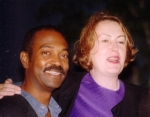 He gave up drugs and rekindled his passion for painting. He moved in with her and they were very much a couple. Currently they live in Norway where she is a professor of Fine Art at the academy in Oslo.
He gave up drugs and rekindled his passion for painting. He moved in with her and they were very much a couple. Currently they live in Norway where she is a professor of Fine Art at the academy in Oslo.
That night I learned two things, Wyatt Earp’s real name and that some do more, much more.

Lovely. Absolutely lovely.
Great article!
Great story. Thanks!
I’m crying!
This is the history of Los Angeles that I want to read about.
I remember Frank Parker and still have a couple of his bracelets.
You buy art from the person making it directly and sit down and talk about things with them and that which you bought is a reminder of that moment shared. The object becomes living, saturated with that moment.
I don’t want to read plaques commemorating building owners, investors, and real estate agencies. I want the hidden and personal. Too much amazing history glossed over by parking lots and advertisements.
Thanks for sharing your memories and the spirits (visible and invisible) of downtown L.A.
Hey Sean!! This is much more than an article, it is a beautifully written essay that sucked me right in and did not let me go until the last sentence when I was still craving for more. I do remember Troy… I remember the opening party when I came with Scott Rose and you thought we were a gay couple… I remember a few doors down there was a store where they sold Buddhist altars… I remember Troy being spacious and lovely with bare walls that showed the brick and the coffee was great and I remember you behind the counter, the image of which perfectly explains why Tommy would call you Daddy – even though I imagine he’d probably address most individuals whose name he could not remember in the same manner.
The passage of time is something deeply beautiful and a little sad, like life itself. How great to get a good taste of it after almost twenty years.
Thank you!!
Very nice! Thank you for the memories and for stirring my heart and mind.
L.A. misses you and your sweet sensibility more than you will know. And also: your tamales.
I remember Frank sitting weaving bracelets in front of MOCA on Grand Avenue and the curators inside had no idea he was one of the artists they wanted to talk to for a historical show in the works. Sorry to hear of his passing, but glad of this remembrance.
Beautifully written with insight, humor, compassion. You really capture the evanescence of life.
I, too, remember the flower man, and of course, Frank. I have a couple of his frangs. And a self- portrait he gave to me hangs on my wall. It is hard to forget him and the warm ambience of Troy Cafe. Thank you for sharing such fond memories.
How well observed and remembered. These characters come alive through your empathy and writing talent.
what incredibly beautiful portraits. and it sounds like troy was a magical place…
What an eloquent, evocative sharing—-thank you Sean!
I acutually paused and took the time to read this just as my work day was pressing me with the normal urgencies. Thank you for capturing such important memories. I found myself wishing I was at the cafe!
Beautiful! Marcus often talks about his time with you and Café Troy – I think that some of his best and favorite memories are from that time…..
That was extremely touching, so many times we forget that even the so called dregs of society have talents, children, lives they might still be living if not for the winds of fate and chance. Thank you for telling their story.
Dear Sean,
I read part of this. It’s great. Now I’m living in Paris, but this makes me want to go back to downtown LA. Thanks, R
Sean,
Thanks for bringing back fond memories of TROY. I do not remember Flower Guy, and yes, I did find Wyatt Earp to be a bit Intense at times, but today I shed a tear for Frank Parker. Even now I have one of his “Frings ” beside me…( Not to one up ya, but he once told me he made these Things and…. nuff said ). I would often see him after the closing of Troy. For a few dollars he’d stand watch over my car while I was in Al’s Bar and every opportunity I’d buy as many Frings as he would sell me and pass them out to people who cared about their origins. During one wet, miserable evening, I saw him next to Denny’s across from the Sheriffs Helipad. It was my birthday and he had been rained out of his place. We spent the next few hours drinking coffee, talking about nothing in particular. As friendly and approachable as he was, there were some things he kept to himself, and I respected that. I left, giving him what I had and from then on, I saw less and less of him. For years, and even now I had kept an eye out for him… Wishful thinking on my part I know. Today he joins a growing list of things I miss and will never be replaced, Antonio’s Hot Dog Cart, Mike the Mechanical Man, The Button Lady, Angeline(Ver. 1.0) Frank Parker and his Frings…
Give Bibbe a hug for me.
Steve
I remember Frank Parker and his warm personality. Thank you, Sean, for the stroll down memory lane! Please send Bibbe my regards.
Cheers,
Andie
I truly love this article, I work on Skid Row and hear so many sterotypes of the people who live down here. I am always grateful when someone writes about the many people who had succesful lives prior to whatever crisis landed them down here and about those who manage to pull out of the madness and return to a productive person in society.
Sean,
This really took me back, thank you. I was reading this in a hotel lobby in Montreal and trying not to get too choked up. I always wondered what happened to Frank.
I read your article. I remember many of those people you mentioned from working in your coffee shop. The flower guy’s real name was David, I believe. When I was working at Troy at nights he would show up and I would always have a sandwich and a can of soda for him. One night before Halloween, I had given him a six pack of soda, a couple of sandwiches and a couple of small pumpkins. He seemed to like that I gave him enough sandwiches that he could share one with his girlfriend at the time.
Thanks for posting this. Brought back some really great memories I had working for you at your coffee house. It was definitely a unique and special place for me. Can’t find anything like it to be my sanctuary now. 🙂
Its so hard for me to remember those fleeting moments from the past. Reading these remembrances have jogged me out of the fog of my memory.
Wow. Well written. Thanks for sharing it with me Paula and to the writer: I am sure you meant a lot to each of these people for treating them with such respect.
Moving. Very moving.
Frank was always so warm and welcoming everywhere you went. He had that instant best friend quality. I was deeply saddened when I heard of his passing, and I had not seen him in may years. I really miss those Troy, Al’s Bar. Yee Mee Loo days with Frank and all the funny and cool people who I occasionally run into. I feel so lucky to have been a part of something wonderful in Downtown, even if it was just a small part. When I look back at that time in my life, I think how cool and lucky was I to be a part of that scene. (Remember the long nights hanging out and talking drinking Asahi beers from next door) priceless.
I am very moved by these writings of Troy Cafe in downtown Los Angeles in the early nineties…
Sean,
Thanks for bringing back such great memories. I’ve never forgotten Frank. I just wished I would have had the guts to ask to take his picture — he had such a wise face with so much character! What a nice guy. I remember wearing my “frang” all the time during those days.
Thank you so much for this wonderful piece. I lived in a loft in Los Angeles, for ten years, and Wyatt Earp was one of the regular people who would come by, always had a smile, and a good word to say, and always a pleasure to speak with.
Something made me google him this morning. He popped into my mind and I wondered how he was after all these years. I am thrilled to see he is well and happy, and I send him and his lovely lady my best wishes.
Sean,
This story was deeply moving – it is exactly the kind of thing I am hoping to find in Los Angeles. Right now, I am a graduate student doing some research for my studies at CGU on coffeehouses with intent of creating a sense of community in the LA region. I am hoping you would be interested in sharing with me your experiences with Troy during its establishment. If you are, please do email me at jesheather@gmail.com. Thank you so much 🙂
Jessica
I remember the Troy Cafe as Home. It has had a welcoming aura about it, and it was a beacon. I also remember the people you spoke of in your article. It was nice to be there and to be encouraged as an artist. How can I say thank you for that? It is far beyond that.
I absolutely loved the Troy Cafe, I saw Beck, Sol, boca de sandia and my bands dream was to play on that stage. But we broke up before we got good enough. Every time I went there it was a fantastic experience. The vibe, people and talent that went through there was incredible. I miss it and I hope the awesome couple that ran it are doing well.
Franklin Roosevelt Parker, from Tubbs, Pennsylvania. There was a Tubbs A, and a then a Tubbs B on the other side o th tracks; segregated coalminers. Drafted into Vietnam like many a 80’s 90’s skid row citizen/denizen. Yes, he knew all the LACHSA kids: they could see the Living Word in his demeanor. He was a Eulipion a la rashaan Kirk. I made him a mix tape when he was dying, but never made it down to the catholic worker to deliver it; a persistent regret. When I had my first psychotic break, frank appeared to me with cherry tomatoes for eyes A FLASH OF THE SPIRIT!!! thank you fro yer reminisciencez…
Our family lived in a bus for four years and parked in the Loft District. We knew Frank Parker and loved him. I have chronicled my memoirs in a photo album of that period of my life. I am an artist and created a collage of Frank Parker. It won 2nd place in an art exhibit. You might remember us. My name is Kris Stanek (formerly Margret (Kris) Corbett)
Of course I remember the Corbett’s! Nice to see you again (virtually). I’d love to see the photo album.
I would love for you to see the album. It was created on Picaboo. It is called “How Should We Then Live.”
Thank you!